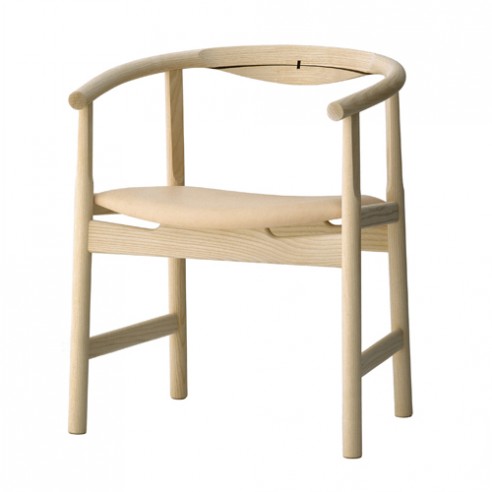Minimal Chinese Chair

PP203
While PP Møbler had been collaborating with Wegner since 1953, providing AP Stolen with the wooden frame for the Teddy Bear Chair, the firm did not work directly with Wegner until 1969 when he designed PP203.
Ref: Hans J. Wegner. A Nordic Design Icon from Tønder. Edited by Anne Blond.
Thanks to its’ frame and downward sloping top rail, PP201 bears a faint resemblance to Wegner’s final China Chair PP56. Seen from the side, however, PP203’s back legs clearly lean forward more than those of the China Chair. It also constructed using fewer parts, giving it a more Spartan appearance. However. This is compensated for visually by the elegant yet modest joinery in the back, which manages to make its’self noticed without being dominant.
PP203 has a strong construction, whether the seat is upholstered with fabric or leather or woven papercord or (PP201), and thus serves as a harbinger of the slightly later ‘ferry chair’(PP63/PP52/PP62). Like the ferry chair, PP203/PP201 is meant to be a dining chair that can be tucked partway in under the dining table.
The model is often used on public premises where food is served. Once used in a cafeteria of the Danish Parliament, it can also to be seen in the dining room of the Møller Centre of Churchill College, Cambridge.
There is a certain kinship between the first chair Wegner designed specifically for PP Møbler (PP201/PP203) and this one, the Captain’s Chair (PP63). While PP63, with its woven seat, has since gone out of production, PP52 (with an attached upholstered seat) and PP62 (with a woven papercord seat) are still being
made.
Both are simply constructed, strong armchairs with a the special back detailed in dark wenge used both as a decorative detail and a functional device to harmonize the appearance of a number of chairs when grouped together. They are made in both a relatively light oak and a very light ash to accentuate this detailed joinery and because these blonde wood types are typically Nordic and suit Danish tastes in furnishing homes and public buildings.
The armrest is shaped to allow the chair to fit well under a table, and the back support is typically ‘Wegnerian’, that is, constructed so that the user can sit well back in the chair and gain the correct support for their back.
Originally the top rail was made of ten, thin laminated pieces of wood, a thin strip of wenge and two pieces of solid wood, all of which – except the wenge – were ‘sliced’ along the grain from the same piece of wood. In 2013, however, PP Møbler began steam-bending the top rail.
PP63 was designed in 1975 for the Danish shipping line, DFDS, to be used in dining areas of their ferries’. The chair was necessarily robust and its wood seasoned, since it had to be able to stand storms at sea and be used daily by a wide assortment of passengers.
The frame of a PP62 was found one day on a beach on Denmark’s west coast near Esbjerg, after having fallen overboard in rough seas somewhere between Denmark and England. The papercord seat was missing, having rotted away in the sea but the rest was intact. PP Møbler wove a new seat for the lucky beachcomber. With the chair’s close attachment to the maritime world, it’s not hard to understand how it got its name, the Captain’s or Ferry Chair.
